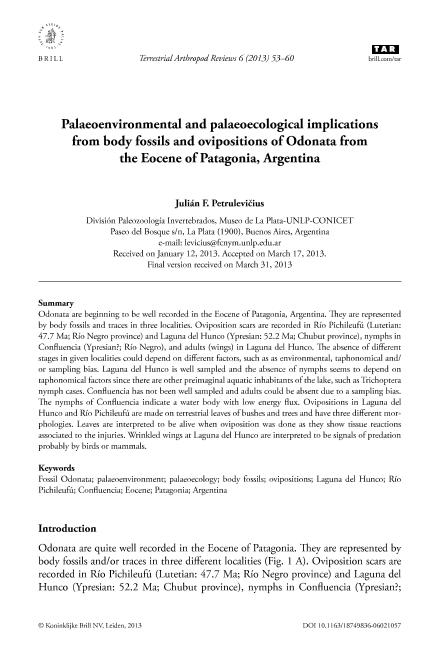Artículo
Palaeoenvironmental and palaeoecological implications from body fossils and ovipositions of Odonata from the Eocene of Patagonia, Argentina
Fecha de publicación:
06/2013
Editorial:
Brill Academic Publishers
Revista:
Terrestrial Arthropod Reviews
ISSN:
1874-9828
e-ISSN:
1874-9836
Idioma:
Inglés
Tipo de recurso:
Artículo publicado
Clasificación temática:
Resumen
Odonata are beginning to be well recorded in the Eocene of Patagonia, Argentina. They are represented by body fossils and traces in three localities. Oviposition scars are recorded in Río Pichileufú (Lutetian: 47.7 Ma; Río Negro province) and Laguna del Hunco (Ypresian: 52.2 Ma; Chubut province), nymphs in Confluencia (Ypresian?; Río Negro), and adults (wings) in Laguna del Hunco. The absence of different stages in given localities could depend on different factors, such as as environmental, taphonomical and/ or sampling bias. Laguna del Hunco is well sampled and the absence of nymphs seems to depend on taphonomical factors since there are other preimaginal aquatic inhabitants of the lake, such as Trichoptera nymph cases. Confluencia has not been well sampled and adults could be absent due to a sampling bias. The nymphs of Confluencia indicate a water body with low energy flux. Ovipositions in Laguna del Hunco and Río Pichileufú are made on terrestrial leaves of bushes and trees and have three different morphologies. Leaves are interpreted to be alive when oviposition was done as they show tissue reactions associated to the injuries. Wrinkled wings at Laguna del Hunco are interpreted to be signals of predation probably by birds or mammals.
Archivos asociados
Licencia
Identificadores
Colecciones
Articulos(CCT - LA PLATA)
Articulos de CTRO.CIENTIFICO TECNOL.CONICET - LA PLATA
Articulos de CTRO.CIENTIFICO TECNOL.CONICET - LA PLATA
Citación
Petrulevicius, Julian Fernando; Palaeoenvironmental and palaeoecological implications from body fossils and ovipositions of Odonata from the Eocene of Patagonia, Argentina; Brill Academic Publishers; Terrestrial Arthropod Reviews; 6; 1-2; 6-2013; 53-60
Compartir
Altmétricas




